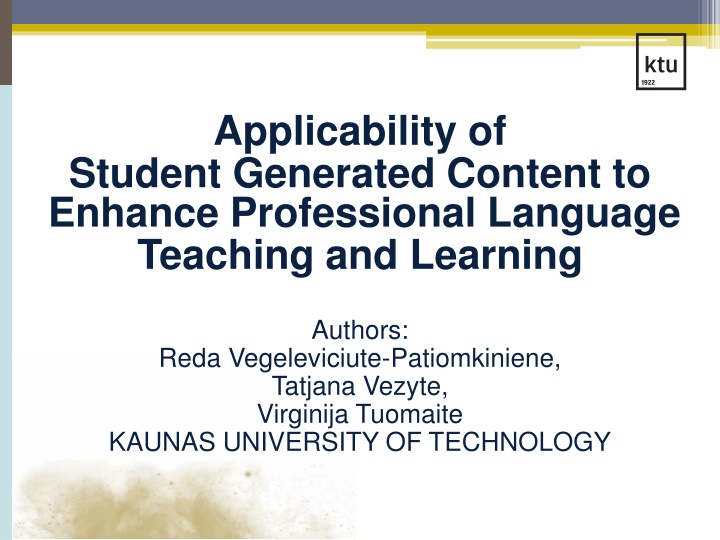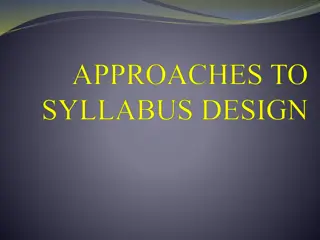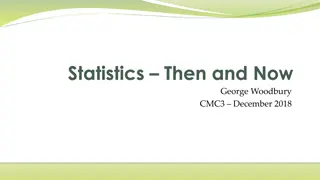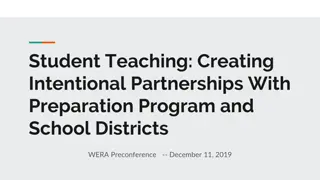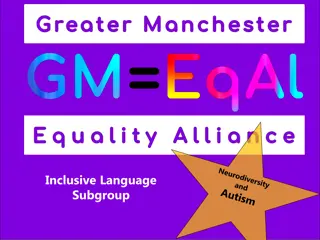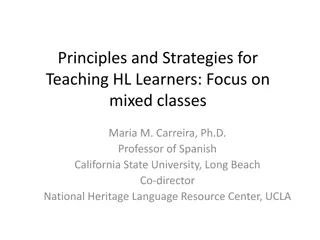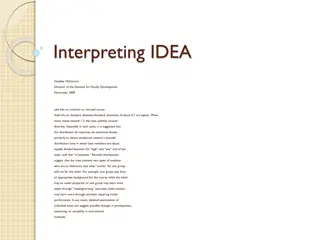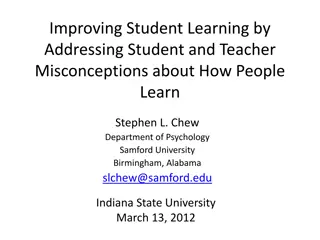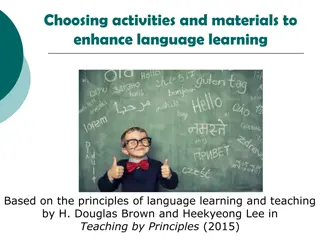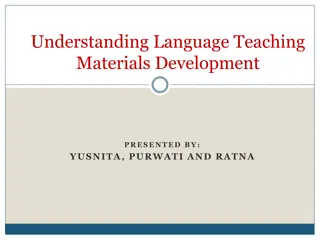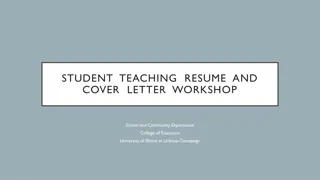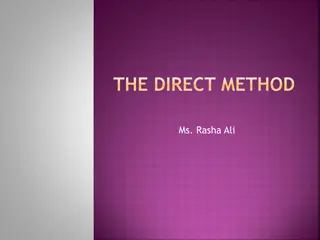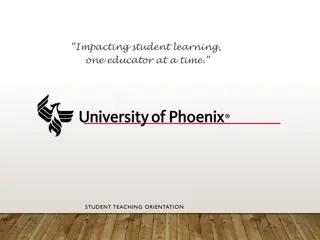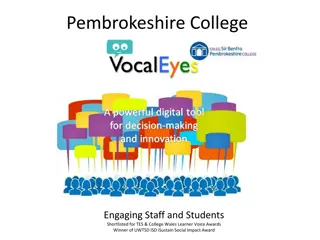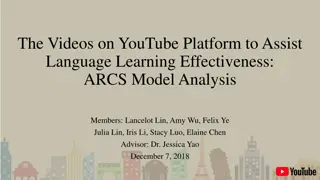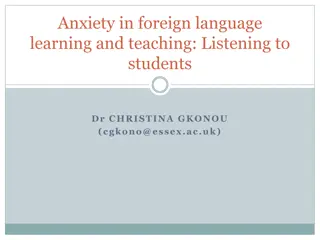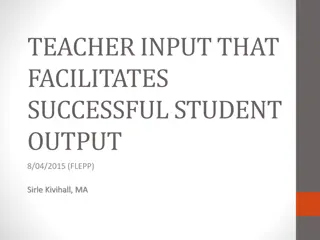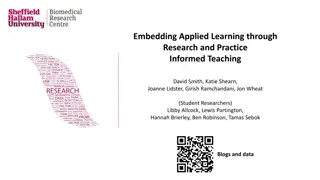Enhancing Language Teaching Through Student-Generated Content
Explore the benefits and drawbacks of incorporating student-generated content in professional language teaching and learning. Discover various forms of student-generated content and its impact on course materials. Delve into relevant literature focusing on online learning and student-created content like podcasts, wikis, and peer assessments.
Download Presentation

Please find below an Image/Link to download the presentation.
The content on the website is provided AS IS for your information and personal use only. It may not be sold, licensed, or shared on other websites without obtaining consent from the author.If you encounter any issues during the download, it is possible that the publisher has removed the file from their server.
You are allowed to download the files provided on this website for personal or commercial use, subject to the condition that they are used lawfully. All files are the property of their respective owners.
The content on the website is provided AS IS for your information and personal use only. It may not be sold, licensed, or shared on other websites without obtaining consent from the author.
E N D
Presentation Transcript
Applicability of Student Generated Content to Enhance Professional Language Teaching and Learning Authors: Reda Vegeleviciute-Patiomkiniene, Tatjana Vezyte, Virginija Tuomaite KAUNAS UNIVERSITY OF TECHNOLOGY
Contents Defining Student Generated Content Proportion of SGC in a Course The Benefits and Drawbacks of SGC Based on Literature Review The Case of KTU: SGC Forms KTU Students Approach: Benefits and Drawbacks of SGC Conclusions
Defining Student Generated Content created either by the learners, or by learners of comparative demographics, for example students of a similar age, nationality or learning context. Learner generated content might refer to any stage of the learning or teaching process: from designing the syllabus, through input into task design and methods of assessment (Christine Muir).
Defining Student Generated Content The forms of student generated content such as papers, essays, lab reports, etc. have been included in the educational process for a long time, but in majority of its usage has been marginalized by sharing it between two persons - that is educator and student (John Sener).
Three Types of Course Content by Judith V. Boettcher Prepackaged authoritative content materials collected into a textbook, representing vetted scholarship to provide content containing the core concepts and principles of the course 30 to 40 % Materials produced specifically for a course by a faculty member 30 % Guided learning materials Interactive and spontaneous performance content Materials created and identified by students in the process of learning 30 to 35 %
Extended by students Student generated content Created by students Identified by students
Related Literature Overview Focuses on online learning Deals with content created by students Mostly analyzes certain forms of SGC: podcasts, wikis, quiz questions, peer assessment Mainly looks into students perception of SGC practice
Positive Learning Outcomes of SGC Enhances creativity Encourages critical thinking Promotes engagement Increases digital literacy, multi-literacy Reveals problematic language areas Reveals the most engaging and relevant themes Results in product of long lasting value Exposes emergent terminology
The Disadvantages of SGC Inconsistent quality due to quantity and complexity of online resources Lack of originality Plausible breach of academic integrity Time-consuming preparation, detailed explanation and guidances through the process Complicated and time-consuming assessment of the process and final result
Study Programs at Two Different Faculties of KTU Faculty of Chemical Technology Applied Chemistry Chemical Technology and Engineering Food Science and Technology Sustainable Engineering and Ecotechnology Faculty of Informatics Informatics Informatics Engineering Information Systems Multimedia Technologies Software Systems
Academic and Technical Communication in English (Level C1) Proportion of Applying SGC in the Module 20% - individual work IN + IN ; 20% - tests 15% - scientific text analysis 15% - conference presentations 30 % - exam
SGC Forms Applied at KTU for Language Learning Teamwork Problem Solving (including mini- research, concept mapping, force field analysis, collaborative writing) Oral academic presentation Scientific article analysis + Glossary
INDIVIDUAL WORK 1 Problem solving assignment 1. 2. 3. 4. Forming a team (3-4 members) Prescribing roles: a leader, a researcher, a writer, an editor, etc. Identifying/centralizing a problem Choosing research methodology (literature review, interview, survey, observation, discussion, etc.) Conducting research Providing a solution to a problem Writing a report (800-1000 words) OBLIGATORY elements in the structure: title page, summary or abstract, introduction, main body, conclusions, references. (For more info please see the course book) Providing a list of references 10. Preparing an informal presentation on overall teamwork process and experience 11. Filling in self-assessment forms and assessment forms for the other team members 5. 6. 7. 8. 9.
Samples of Problems Chosen to Analyze by Students Do students have an efficient learning environment? Time management in student s life How can students avoid procrastinating? Internet security threats Cloud data storage Robotics in Medicine Cyber security in Lithuania In vitro meat production
Benefits and Drawbacks of Problem Solving Report by Students makes you think outside the box and learn new information teaches time management and following deadlines learned more about research methodologies and displaying results good academic writing practice, but very different styles of each student in the team new and engaging activity, which gives a freedom of choice time consuming because of different approach to work within the group difficult to agree upon the theme sharing workload was challenging some team members disappear at critical moment structural parts of report were new and confusing to work out
Sample of Mini Research Task Find a piece of news in your professional field in English (worthy and interesting in terms of study field as well as language learning) Write a brief report on how it helped you to expand your knowledge profession-wise, why you recommend to read/watch it to your colleagues Comment on how it helped you to improve your language skills, specify a few areas (vocabulary, reading, listening, speaking, pronunciation)
Benefits and Drawbacks of Mini Research Task by Students expanding my knowledge of study area and knowledge of language learning new professional vocabulary improving comprehension opportunity to chose what is useful and interesting to us using dictionaries and learning pronunciation not easy to find reliable sources writing comments is difficult selecting the right content suitable information some specific professional information may be too difficult because we haven t learned about some concepts yet
SGC Products Written reports with infographics Concept maps Presentations Scientific literature reviews Glossaries Games Etc.
Conclusions (1) Newly applied SGC forms require very careful and clear explanation, time management and guidance by the educator Pre-questioning students about the experience of working with SGC based tasks would be beneficial SGC based tasks enhance creativity and critical thinking Helpful in developing learning materials based on newly emerging concepts, trends, vocabulary SGC can be time-consuming and complicated in terms of assessment
Conclusions (2) Freedom of choice motivates students, but their choices have to be monitored step by step in order to achieve qualitative content and avoid plagiarism Mini research is less reliable and efficient than long-term work (e.g., problem solving report), but it could be an inclusive part of the longer assignment SGC based assignments have potential in creating future learning content for language learning as well as expanding knowledge in specific study field
Further Research SGC applicability feedback and perception by lecturers More insights into applying short-term tasks of SGC during computer labs Extended possibilities of applying SGC in creating tests, quizzes, questionnaires, peer assessment, etc. The right proportion of SGC in a foreign language course Practice with extended forms of SGC
References Boettcher, J. V. (2006) The Rise of Student Performance Content. Campus Technology. https://campustechnology.com/articles/2006/02/the-rise-of-student-performance-content.aspx European Higher Education Area and Bologna Process http://www.ehea.info/page-student-centred-learnin Lambert, C., Philp, J. , Nakamura, S. 2016. Learner-generated content and engagement in second language task performance. Language Teaching Research. Volume: 21 issue: 6, page(s): 665-680. Meddings, L. and Scott Thornbury Teaching Unplugged Dogme in English Language Teaching. 2009: Delta Publishing. Muir, C. (2018). Using learner-centred content in the classroom Part of the Cambridge Papers in ELT series. [pdf] Cambridge: Cambridge University Press. https://languageresearch.cambridge.org/images/Language_Research/CambridgePapers/Cambri dgePapersInELT_LearnerCentredContent_2018_ONLINE.pdf Murray, D., McGill, T., Thompson, N., Toohey, D., (2017), Can learners become teachers? Evaluating the merits of student generated content and peer assessment, Issues in Informing Science and Information Technology, 14, , pages 21 - 33. http://iisit.org/Vol14/IISITv14p021-033Murray3464.pdf P rez-Mateo, M.Maina, M.F, Guitert,M., Romero, M. 2011. Learner Generated Content: Quality Criteria in online Collaborative Learning. European Journal of Open, Distance and E-Learning 14 (2). Phillips, B. Student-Produced Podcasts in Language Learning Exploring Student Perceptions of Podcast Activities, IAFOR Journal of Aducation, Volume 5-Issue 3- Winter 207. Sener, J. In Search of Student-Generated Content in Online Education. 2007. E-mentor nr 4 (21).
Thank you for your attention. Any questions?
Applicability of Student Generated Content to Enhance Professional Language Teaching and Learning Authors: Reda Vegeleviciute-Patiomkiniene, Tatjana Vezyte, Virginija Tuomaite KAUNAS UNIVERSITY OF TECHNOLOGY
